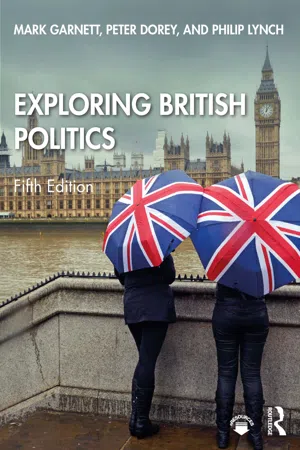
Exploring British Politics
Mark Garnett, Peter Dorey, Philip Lynch
- 654 pages
- English
- ePUB (mobile friendly)
- Available on iOS & Android
Exploring British Politics
Mark Garnett, Peter Dorey, Philip Lynch
About This Book
Exploring British Politics is a concise, comprehensive, and accessible guide to the subject. Fully updated and revised, the new edition covers developments since 2016 in the role of the executive, Parliament, the civil service, political parties, general elections, party ideology and membership, as well as examining turmoil and leadership battles within the Labour and Conservative parties, the politics of growing inequality, demographic trends and their political consequences, and the future of the UK itself. Stimulating critical analysis and lively debate, it provides new perspectives on two key themes – the health of British democracy and the transition from traditional models of government to more flexible forms of 'governance'.
Key features include:
- a comprehensive analysis of the 2019 general election, Brexit developments since the 2016 Referendum to today's ongoing negotiations, and the shadow cast by the COVID-19 global pandemic and its implications;
- topical coverage of the fall of the Corbyn and May leaderships, the new Starmer and Johnson era, the rise and fall of the 'Change UK' party, the economic crisis, the role of special advisers, new social movements such as Extinction Rebellion and Black Lives Matter, and much more;
- extensive guides to further reading at the end of each chapter; and
- rich illustrations visually representing examples and data.
Whilst the book provides an essential historical background, contemporary issues are to the fore throughout and readers are encouraged to assess critically received wisdoms and develop their own thoughts and ideas. Whether studying the subject for the first time or revisiting it, Exploring British Politics is the ideal undergraduate text.
Frequently asked questions
Information
Part 1
Chapter 1
Learning outcomes
- appreciate that the subject matter of politics is open to competing interpretations;
- understand that there are various approaches to the study of British politics;
- become familiar with the concept of ‘liberal democracy’;
- understand the issues involved in a shift from ‘government’ to ‘governance’ in the UK.
Introduction
- Context: exploring the historical, economic, and social background to contemporary British politics, and the ways in which it can be studied.
- Constitution and institutions: covering the uncodified British constitution, the core executive, Parliament, and the legal system.
- Multi-level governance: explaining recent developments relating to the changing state, devolution within the UK, local government, and the impact of the EU prior to the decision to withdraw.
- Political parties: discussing party systems, ideology, and the structure of the main parties.
- Participation: assessing electoral systems, voting behaviour, referendums, and pressure groups.
UK politics, representative democracy, and the ‘Westminster model’
Aspect of political system | Features of the Westminster model |
|---|---|
Constitution | Uncodified constitution; no special procedures required for constitutional amendment |
Sovereignty | Parliamentary sovereignty – supreme legislative authority of Westminster; no other body can overturn parliamentary legislation |
Core executive | Prime ministerial government – prime minister is the predominant figure in cabinet system |
Collective and individual responsibility | Ministers accountable to Parliament |
Bureaucracy | Civil service – neutral, permanent, knowledgeable Public service ethos, but perception that ‘Whitehall knows best’ |
Executive-legislative relations | Dominant executive – fusion of executive and legislature. Limited parliamentary scrutiny and amendment of legislation; strong party discipline |
Electoral system | Simple plurality electoral system – expected to produce ‘artificial’ parliamentary majorities for winning party; single-party government is the norm; regular, free elections ensure accountability of decision-makers |
Party system | Two-party system – clear choice for voters Mass parties evolved into ‘catch-all’ parties with broad appeal |
Judiciary | Courts cannot challenge constitutionality of legislation Limited powers of judicial review, though ministers and officials are not above the law |
Territorial politics | Unitary state – political power concentrated at the centre. Weak local government – no constitutional protection No subnational government in Great Britain – Scottish Office and Welsh Office represent interests at the centre |